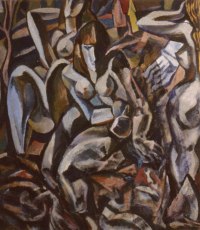In 1998, I visited the former Soviet Union for the first time. The peoples’ appreciation for art, literature, music, poetry made a strong impression on me, because I had been taught by my government that they were evil. But, I learned from the writings of Dr. Daisaku Ikeda to appreciate the depth of peoples’ lives, and study culture. In doing so, I found in Russia and the other countries I visited in the former Soviet Union, extraordinarily rich appreciation for life, and I learned many life lessons that I continue to use today.
Evening – Timofeev 1973 Oil on Canvas
In this collection, some of the artwork is not pretty or inviting. Glasnost, or openness, was chosen as a theme for the government’s restructuring of its values. Arguably, the foremost spiritual-political leader sensed intellectually that the economic changes (perestroika) that were underfoot, to be valid and far reaching necessitated freedom. Like the first value in the Bill of Rights, freedom of expression, or openness, became the password of the day, and artists began painting and sculpting with great intellectual abandon. The art was often called Soviet Avant-Guard.
Morning Of Our Motherland – Shurpin 1952 Oil on Canvas
Other paintings more suited for museum than anywhere else, as they represent the worst of humanity. “Morning Of Our Motherland” is a large oil painting and was commissioned in 1952 by the murderous, mentally deranged dictator who wanted the world to think he was compassionate. Gremitskih’s “Delegates” shows the pride of Communist Party loyalists whose badges supported the ten’s of millions of people who were murdered, imprisoned, and indentured by their own people.
Stalin commissioned this painting of himself to hang in one of the top government offices.
Painting on exhibition at the Director’s Guild in Hollywood for screening of HBO epic film “Stalin” starring Robert Duvall, and directed by Ivan Passer. (1992)
Holiday Of A Harvest – Sergeeva 1959 Oil on Canvas
In this collection, some of the artwork is not pretty or inviting. Glasnost, or openness, was chosen as a theme for the government’s restructuring of its values. Arguably, the foremost spiritual-political leader sensed intellectually that the economic changes (perestroika) that were underfoot, to be valid and far reaching necessitated freedom. Like the first value in the Bill of Rights, freedom of expression, or openness, became the password of the day, and artists began painting and sculpting with great intellectual abandon. The art was often called Soviet Avant-Guard.
Morning In The Kitchen – Gremitskih 1952 Oil on Canvas
In this collection, some of the artwork is not pretty or inviting. Glasnost, or openness, was chosen as a theme for the government’s restructuring of its values. Arguably, the foremost spiritual-political leader sensed intellectually that the economic changes (perestroika) that were underfoot, to be valid and far reaching necessitated freedom. Like the first value in the Bill of Rights, freedom of expression, or openness, became the password of the day, and artists began painting and sculpting with great intellectual abandon. The art was often called Soviet Avant-Guard.
Look closely for images depicting hatred for authoritarianism. Artists that publically unveiled their opposition to the culture and government supporting it, were imprisoned and sentenced to death. Very few artists took the risk to express themselves freely, and there is little such artwork extant, as the authorities destroyed what they could lay their hands on. This beautiful and heart-wrenching oil painting shows the underbelly of social realism, as one of a few that ponders human rights and survived the brutality of the Soviet era.
The truth of Dr. Ikeda’s discussion on the sanctity of the Russian heart shows greatly in “Holiday of Harvest” and “Morning in the Kitchen”. Painted by Sergeeva and Gremitshih respectively, both respected members of the Artist Union that had sole authority to provide living provisions and supplies to artists–the painters used their talent to produce gorgeous paintings of what appears to be simple life in a communal rural Russia. However, looking deeper, we can see the artists’ ‘hidden’ disdain for the lives of people who had lost sense of themselves through the life and death realities of a country that killed over 50 million of its own citizens. Look closely and you will see the heart of these two artists who risked their lives artistically exposing awareness that their society was corrupt and dangerous.




